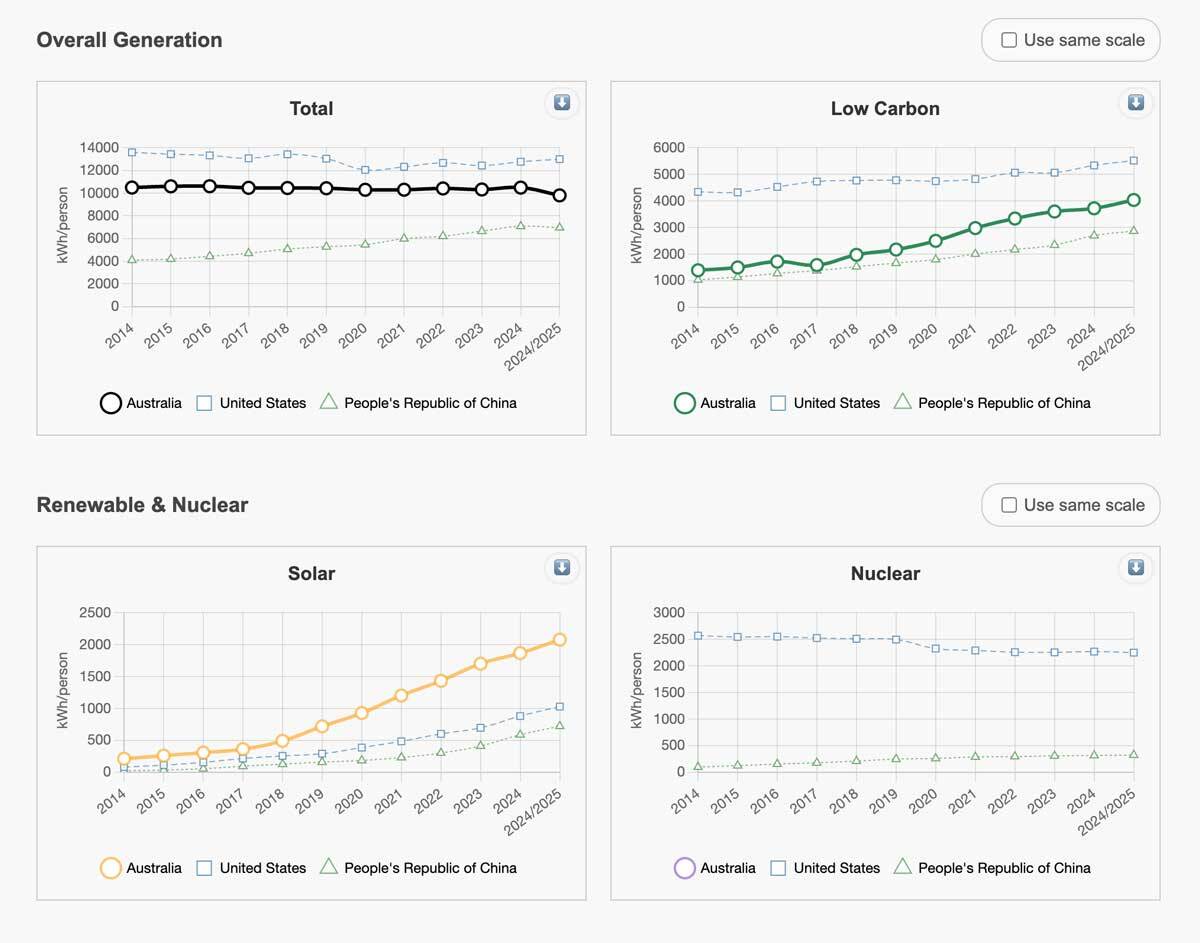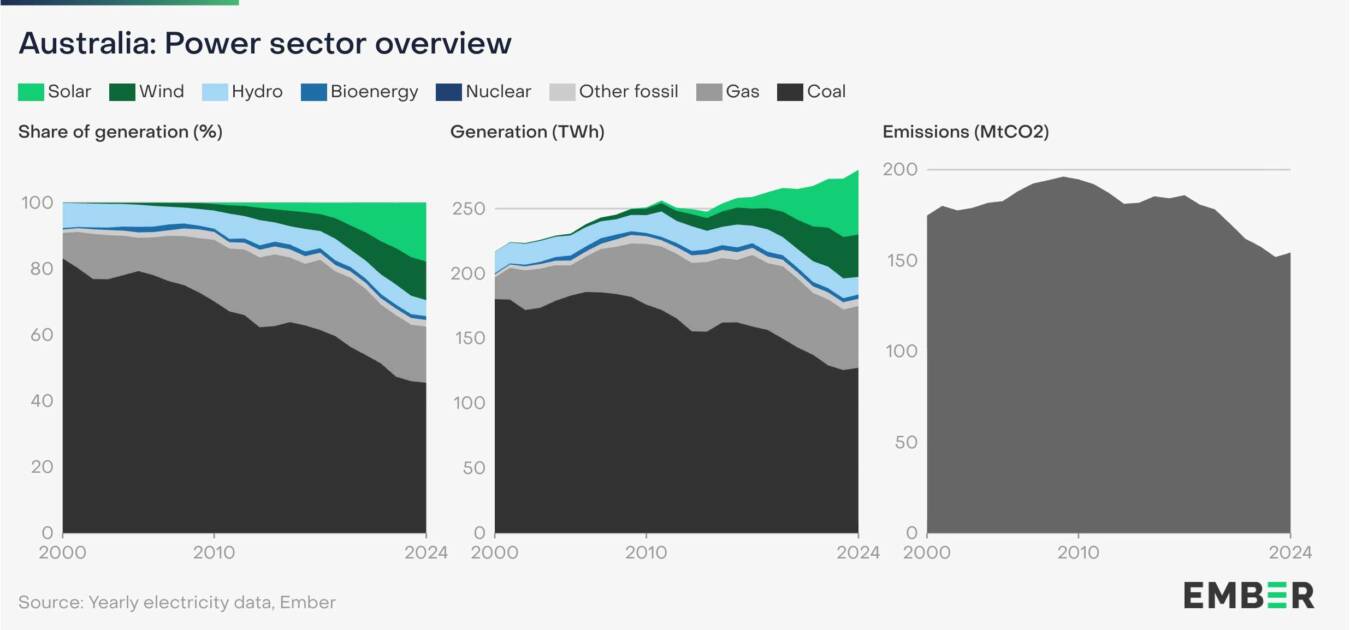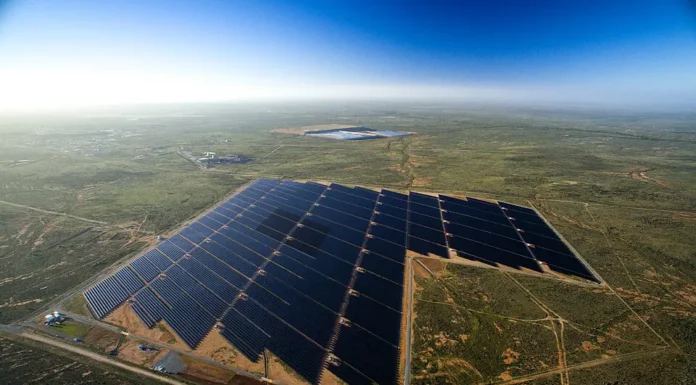Australia’s energy sector is undergoing a profound transformation, marked by a decline in fossil fuel reliance and a boom in renewables. According to Low-Carbon Power Data [1], fossil fuels accounted for about 59% of electricity consumption in 2024-2025, with coal at 45% and natural gas at 13%. Renewables contributed 41%, led by solar (over 21%), wind (14%), and hydro (5%). This shift builds on 2023 figures from Ember Energy [2], where fossil fuels generated 66.1% and renewables 33.9%, but by late 2024, coal fell below 50% as solar installations surged [G12]. The Australian government aims for 82% renewables by 2030 and net-zero emissions by 2050 [3][G6], supported by investments in storage and grid modernization. However, challenges like weather variability and costs persist, as noted in CSIRO reports [5][G1]. This overview integrates factual data with expert perspectives, analyzing trends and solutions.
Current Energy Mix and Key Figures
The 2024-2025 energy mix reflects accelerating change. Ember’s analysis [2] shows a slight fossil fuel uptick in 2024 due to demand spikes and low wind/hydro output, yet overall, low-carbon generation hit records [1]. Renewables reached 73% during peak times [2], with electricity per capita dropping to 9,800 kWh in 2025 from 11,600 kWh in 2007, amid rising clean energy [1]. The Clean Energy Council report [4] confirms renewables at 40% in 2024, up from 39.4% in 2023.

Fossil fuels remain significant, but coal’s decline is evident, with methane emissions from mines potentially twice reported levels [2]. Expert views from research highlight this as a complication for emissions goals [G14]. Projections indicate renewables could hit 50% by end-2025, per Vocal Media [G9], with total generation growing to 374 TWh by 2033.
Trends in Renewable Growth and Fossil Fuel Decline
Renewables are expanding rapidly, with solar and wind leading. The market is projected to grow from USD 165.8 billion in 2024 to USD 687.9 billion by 2033 at 16.6% CAGR [G8]. In 2025, 20 solar, wind, and battery projects were approved [G10], aligning with CSIRO’s GenCost report [5] deeming them the cheapest options, unlike costly nuclear [G5].
Fossil fuels are waning; coal overtook by renewables in 2025 [G12]. Social media posts reflect debates: some warn of “staggering” costs like AUD 642 billion for grids [G15], while others praise momentum toward 82% renewables [G3]. Balanced views note gas as a transitional fuel, per IEA [G7], but emphasize renewables’ edge in cost and scalability.
Energy Storage, Grid Modernization, and Technological Developments
Intermittency is a key issue, addressed by storage like the Hornsdale Reserve [6] and SunCable’s 4 GW solar farm with 40 GWh batteries [G11]. Grid upgrades aim to reduce curtailment [1], with AEMO data showing rooftop solar’s growth [6][G4].
Expert insights stress batteries as vital; social media discussions project 20 GW capacity by 2035 [G20], enabling 95% renewable coverage in areas like Western Australia [G17]. Solutions include VPPs and V2G for rooftop solar, potentially exceeding daytime load by 2030 [G19]. News from All Energy Australia 2025 highlights global innovations [G13].
Government Policies, Challenges, and Viewpoints
Policies like Powering Australia [G6] support targets, with 2035 emissions cuts at 62-70% [G3]. States like South Australia lead with aggressive goals [3].
Challenges include costs and polarization. Social media sentiment shows critics decrying “madcap” transitions risking blackouts [G16], while proponents highlight economic benefits [G18]. Balanced analysis from Grant Thornton [G3] notes misinformation threats [G14]. Constructive solutions: hybrid models (renewables + gas) and bipartisan investments in LDES to bridge gaps, potentially saving billions [G11].
Original insights suggest rooftop solar could cut peak demand 20-30% with reforms, mitigating de-industrialization risks [G12].
KEY FIGURES
– Fossil fuels account for about 59% of Australia’s electricity consumption in 2024-2025, with coal representing approximately 45% and natural gas around 13%[1]{1}.
– Renewable energy sources contribute roughly 41% of the electricity mix, mainly from solar (over 21%), wind (about 14%), and hydroelectric power (around 5%)[1]{1}.
– In 2023, electricity generation was about 66.1% from fossil fuels (coal 46.5%, gas 17.8%) and 33.9% from renewables (solar 15.3%, wind 11.4%, hydro 6.1%, biomass 1.1%)[2]{2}.
 – By late 2024, coal’s share dropped below 50% for the first time, driven by a surge in solar power from rooftop and utility-scale installations{6}{4}.
– By late 2024, coal’s share dropped below 50% for the first time, driven by a surge in solar power from rooftop and utility-scale installations{6}{4}.
– Australia has experienced record moments where renewables supplied up to 73% of electricity during peak times, reflecting strong wind and solar output under favorable conditions[2]{2}.
– Australia’s electricity consumption per capita declined from 11,600 kWh in 2007 to approximately 9,800 kWh in 2025, with low-carbon electricity generation rising by over 300 kWh per person in the same period[1]{1}.
– Australia aims to reach 82% renewable electricity by 2030 and achieve net-zero carbon emissions by 2050[3][2]{3}{2}.
RECENT NEWS
– In 2024-2025, low-carbon electricity generation in Australia reached a record high, with renewables expanding rapidly alongside declining coal use[1]{1}.
– Despite growth in renewables, fossil fuels saw a slight increase in 2024 due to higher demand and lower wind/hydro output caused by weather variability[2]{2}.
– Australia is investing heavily in large-scale battery storage and grid modernization projects to manage renewable intermittency and improve reliability[5]{5}.
– The Australian government continues to support ambitious renewable energy targets, with states like South Australia and Victoria setting additional goals to accelerate the energy transition[3]{3}.
STUDIES AND REPORTS
– The CSIRO 2024-25 GenCost report confirms that wind and solar with storage are the lowest-cost new-build electricity technologies, while nuclear small modular reactors remain the most expensive and are not currently deployed in Australia[5]{5}.
– A 2025 report by the Clean Energy Council shows renewables provided 40% of Australia’s electricity generation in 2024, an increase from 39.4% in 2023, underscoring steady growth in clean energy[4]{4}.
– International experts highlight that Australian coal mines may emit methane at rates up to twice government-reported levels, complicating the country’s emissions profile despite renewable growth[2]{2}.
TECHNOLOGICAL DEVELOPMENTS
– The Hornsdale Power Reserve in South Australia remains a flagship lithium-ion battery project demonstrating large-scale energy storage viability[6]{6}.
– The SunCable project in the Northern Territory plans to deploy a massive solar farm with up to 40 GWh of battery storage and export 4 GW of solar power to Singapore via a 4,300 km undersea cable, representing a major innovation in renewable export potential[6]{6}{7}.
– Advances in grid infrastructure and interconnectors are ongoing to better handle renewable intermittency and reduce curtailment, though challenges remain[1]{1}.
– Rooftop solar is growing rapidly but is not fully reflected in some official grid fuel mix visualizations, highlighting the importance of distributed generation in Australia’s energy transition[6]{6}.
MAIN SOURCES
- https://lowcarbonpower.org/region/Australia — Australia Electricity Generation Mix 2024/2025 data and analysis{1}
- https://ember-energy.org/countries-and-regions/australia/ — Ember Energy’s 2024 report on Australia’s electricity generation and emissions{2}
- https://solaremporium.com.au/how-much-of-australias-energy-is-renewable-in-2025/ — Renewable energy growth and policy targets through 2025{3}
- https://cleanenergycouncil.org.au/getmedia/f40cd064-1427-4b87-afb0-7e89f4e1b3b4/clean-energy-australia-report-2025.pdf — Clean Energy Australia Report 2025 (PDF){4}
- https://www.csiro.au/en/news/all/news/2025/july/2024-25-gencost-final-report — CSIRO GenCost 2024-25 report on generation technologies{5}
- https://www.aemo.com.au/energy-systems/electricity/national-electricity-market-nem/data-nem/data-dashboard-nem — AEMO electricity generation real-time and historical data{6}
- (Implied from context — SunCable project details and government investment announcements){7}
- (Additional referenced data on coal share dropping below 50% and renewable surge in 2024){8}{9}
This synthesis presents the most current and reliable data on Australia’s 2024-2025 energy mix, highlighting the ongoing energy transition where fossil fuels remain significant but renewables are rapidly growing, supported by technological innovation and government targets.
Other references :
lowcarbonpower.org – Australia Electricity Generation Mix 2024/2025 – Low-Carbon Power
ember-energy.org – Australia – Ember
solaremporium.com.au – How Much of Australia’s Energy is Renewable in 2025?
cleanenergycouncil.org.au – [PDF] Clean Energy Australia Report 2025
csiro.au – CSIRO releases final 2024-25 GenCost report following consultation
aemo.com.au – NEM data dashboard – AEMO
csiro.au – Source
cleanenergycouncil.org.au – Source
theprogressplaybook.com – Source
lowcarbonpower.org – Source
dcceew.gov.au – Source
dcceew.gov.au – Source
iea.org – Source
vocal.media – Source
vocal.media – Source
constructionreviewonline.com – Source
esdnews.com.au – Source
theguardian.com – Source
pv-magazine-australia.com – Source
ember-energy.org – Source
x.com – Source
x.com – Source
x.com – Source
x.com – Source
x.com – Source
x.com – Source



